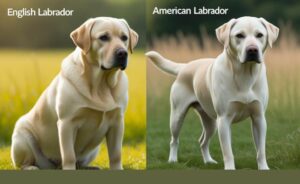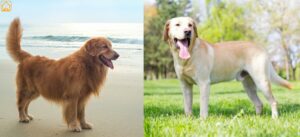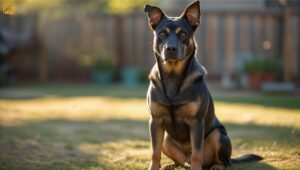The name (Goldador) itself says that it is a mix of half Labrador Retriever and half Golden Retriever. This mixed breed dog takes the Lab’s playful, loyal energy and combines it with the Golden’s gentle, affectionate nature.
These pups are friendly, intelligent, and eager to be part of the family’s every adventure. From hiking buddies to therapy dogs, Goldadors have found their way into all kinds of homes and hearts.
Goldadors aren’t just a random mix, they’re often bred intentionally to create a companion that excels as a service dog, guide dog, or active family pet. Both parent breeds have impressive resumes when it comes to helping humans, and their offspring are no different.
If you’re dreaming of a tail-wagging best friend who’s up for fetch, snuggles, and everything in between, the labrador and golden retriever mix dog might just steal your heart.
Goldador Origins: The Story Behind the Labrador and Golden Retriever Mix
The Goldador is a mix of the Labrador Retriever and the Golden Retriever. It was developed to combine the best traits of both breeds, including intelligence, trainability, and a friendly nature. This mix began a few decades ago, mainly for service and therapy roles because of their calm and dependable behavior.
Labradors come from Newfoundland, where they worked with fishermen. Golden Retrievers were bred in Scotland as gentle hunting dogs. Together, they create a loyal and eager-to-please companion suited for both work and family life.
If you’re interested in the full history of Golden Retrievers or Labradors, the American Kennel Club and The Labrador Site offer in-depth articles on each breed’s background.
Goldador Appearance: Size, Colors, and Coat Types
You know what’s funny? Many people think all Goldadors look the same, but that’s not true! Since they’re a Labrador and Golden Retriever mix, their looks can really vary. Each Goldador is a unique blend of both parents. Let’s take a closer look at what they can look like.
Goldador Size
Goldadors are typically medium to large dogs. Most full grown golden labradors stand between 21 and 25 inches at the shoulder and weigh 55 to 80 pounds. Males are usually a bit larger than females, but every dog is unique. Their sturdy, athletic build makes them great companions for outdoor adventures.
| Gender | Height (inches) | Weight (pounds) |
| Male | 23-25 | 65-80 |
| Female | 21-23 | 55-70 |
Goldador Colors

Goldadors come in more colors than you might expect. While many imagine a golden coat, they can actually be yellow, cream, black, chocolate, or even a mix of shades. Their coat color depends on their parents, and some even have subtle highlights or shading. I once met a white Goldador named Snowball, she looked just like a little cloud!
Goldador Types
The coat of a labrador and golden retriever mix puppy is usually dense and double-layered, offering water resistance (a nod to their retriever roots). Some Goldadors have shorter coats like a Lab, others inherit the Golden’s slightly longer, wavy hair. Most will shed year-round and “blow coat” in spring and fall, so get ready for regular brushing sessions! These pups are definitely not hypoallergenic, but their soft fur is perfect for snuggling.
- Short, dense coat: More like a Labrador parent, easy to maintain, moderate shedding.
- Medium, wavy coat: More like a Golden Retriever, requires frequent brushing, heavier shedding.
Whatever their looks, every Goldador brings their own style to the party. Whether you get a golden retriever lab mix black, yellow, or somewhere in between, you’ll end up with a beautiful, athletic, and lovable companion.
Goldador Coat Care: Grooming and Shedding
If you’re imagining fur all over your floors, you’re not wrong, Goldadors do shed a lot! This mix of Labrador and Golden Retriever is known for heavy shedding. But don’t worry, with the right brush and some regular grooming, you can keep their coat (and your home) under control.
Goldadors have thick, double-layered fur, just like their Lab and Golden Retriever parents. This means they shed all year, and even more during spring and fall. If you like a super clean house, be ready to vacuum often. But their soft, cuddly fur makes it all worth it!
- Brushing: Aim for brushing at least 2–3 times a week. During shedding seasons, daily brushing helps keep loose fur under control and reduces mats and tangles, especially in pups with longer, wavier coats.
- Bathing: Goldadors are water lovers, but they don’t need frequent baths, once every 1–2 months is plenty, unless your dog rolls in something unspeakable (which, let’s be honest, is likely to happen). Use a gentle, dog-specific shampoo to avoid drying out their skin.
- Ears, Teeth, and Nails: Those adorable floppy ears can trap moisture and dirt. Check and clean them weekly to prevent infections. Brush your Goldador’s teeth several times a week, and trim their nails every few weeks to keep those paws healthy.
- Shedding Solutions: Invest in a good de-shedding tool or slicker brush. And don’t be surprised by fur on your clothes, couch, and, well, everywhere. Lint rollers become your new BFF.
Pro tip: Start grooming routines early, especially if you’ve got a goldador puppy. Make it fun, treats, praise, even a silly song. Turn grooming into bonding time instead of a wrestling match. Your future self will thank you.
One more thing: Goldadors are not hypoallergenic. Their hair and skin flakes can spread around the house, which might bother people with allergies, so keep that in mind if you or a family member is sensitive. If you’re set on a retriever mix but need a low-shedder, you might want to look elsewhere (sorry, Goldador fans!).
Goldador Diet Guide: What to Feed and How to Keep Them Healthy
Goldadors love to eat and will often try to eat anything they find. The labrador and golden retriever mix comes with a Labrador’s famous appetite and the Golden’s enthusiasm for, well, everything. It’s important to feed them the right amount. Too much food can make them gain weight and get sick.
Always choose a high-quality, well-balanced dog food, whether it’s kibble, wet food, or a vet-approved raw diet. Goldadors are active and need plenty of energy. Adult Goldadors do best with food that has enough protein and not too much fat or calories.
| Life Stage | Protein (%) | Fat (%) | Feeding Frequency |
| Puppy | 22+ | 8–15 | 3–4 times/day |
| Adult | 18–22 | 5–10 | 2 times/day |
| Senior | 18–20 | 5–8 | 2 times/day |
Tips for Feeding Your Goldador:
- Watch their weight! Obesity is a real problem for both Labs and Goldens, so measure meals and skip the table scraps. Use treats for training, not as a love language.
- Choose food based on age, size, and activity level. Active Goldadors may need more calories, but couch potatoes require less. Our Adult Dog Feeding Guide provides helpful tips on portion control and balanced meals for everyday life.
- Divide food into two meals a day for adults, this helps prevent bloat (a life-threatening stomach condition) and keeps energy stable.
- Don’t overfeed puppies. Too many calories can fuel rapid growth and increase the risk of joint problems later. Learn what growing dogs really need in our Puppy Food Guide.
- Talk with your vet before switching foods or starting a homemade diet. Every Goldador is unique, and some may need special nutrition for allergies or health concerns. For an overview of essential nutrients and diet types, check out our Dog Nutrition Guide.
Hydration is just as important, always keep fresh water available, especially after exercise or play. And if your Goldador sneaks a snack out of the trash? Don’t panic, but keep an eye on them for signs of stomach upset.
Keep in mind: As your Goldador gets older, they’ll need a well-balanced, nutritious diet to stay healthy and active in their senior years. For helpful tips, check out our article on Senior Dog Diet.
Understanding Goldador Health: Lifespan, Risks, and Wellness Tips
To be honest, welcoming a labrador and golden retriever mix into your home means opening your heart to a dog who will probably live about 10–12 years. Goldadors can be loving companions for over a decade, full of tail wags and muddy paws. But like all breeds, they may inherit some health issues from their parents.
Common Goldador Health Issues
- Hip and Elbow Dysplasia: Both Labs and Goldens are prone to joint issues. Regular exercise, healthy weight management, and joint supplements (with your vet’s okay) can help.
- Eye Conditions: Cataracts and progressive retinal atrophy (PRA) show up in both parent breeds. Annual eye exams are key.
- Ear Infections: Those floppy ears look cute but can trap moisture and bacteria. Clean them regularly and dry thoroughly after swimming.
- Cancer: Golden Retrievers, in particular, have higher rates of certain cancers. While crossbreeding can lower risk, it’s not a guarantee. Regular checkups catch problems early.
- Obesity: It’s not a disease, but it can cause a bunch of them, from diabetes to arthritis. Watch the food and treats, and keep your Goldador active.
- Allergies and Skin Issues: Some Goldadors inherit sensitive skin. Gentle shampoos and a healthy diet can help.
- Bloat (Gastric Dilatation-Volvulus): Large, deep-chested breeds like the Goldador are at risk. Feeding smaller meals, avoiding heavy exercise right after eating, and knowing the signs can be lifesaving.
Learn about common health issues in Goldadors and take the right steps to help your dog live a happy and healthy life.
Lifespan: How Long Do Goldadors Live?
The average labrador and golden retriever mix lifespan is 10–12 years, but some Goldadors (especially those with careful breeding and healthy lifestyles) push past 13. Color doesn’t matter much, but there’s some evidence that chocolate Labs and their mixes may have slightly shorter lives due to increased risk of infections. Most important? Give your Goldador a balanced diet, regular exercise, and lots of love.
How to Keep Your Goldador Healthy
- Schedule annual veterinary checkups and keep vaccines up to date.
- Feed quality food and avoid overfeeding.
- Brush teeth regularly and check ears and skin for signs of problems.
- Spay or neuter unless you’re working with a reputable breeder for health-tested litters.
- Consider pet insurance, unexpected vet bills happen!
And don’t forget the mental health side. Goldadors are social, sensitive souls. They need plenty of interaction, training, and attention. Left alone too long, they can become anxious or destructive.
Key Differences of Goldador vs Golden Retriever and Labrador
You might be wondering, “Why not just get a purebred Lab or Golden?” Great question! Let’s break down what makes the labrador and golden retriever mix unique compared to its famous parents.
| Trait | Goldador | Golden Retriever | Labrador Retriever |
| Temperament | Balanced, eager to please, loyal | Gentle, affectionate, social | Playful, energetic, outgoing |
| Coat | Short to medium, dense, sheds | Medium, wavy, heavy shedder | Short, dense, moderate shedder |
| Colors | Gold, yellow, cream, black, chocolate | Gold, cream, red | Yellow, black, chocolate |
| Trainability | Very high, loves learning | Very high, eager to please | Very high, food motivated |
| Energy Level | High, loves play and work | High, slightly calmer | High, very active |
| Common Uses | Family, service, therapy dogs | Family, therapy, guide dogs | Family, hunting, service dogs |
Finding a Goldador: Breeders, Rescues, and Adoption Tips
Ready to bring a labrador and golden retriever mix home? Here’s the thing, these dogs are popular, but not always easy to find from reputable sources. Whether you want a goldador puppy or a mature rescue, patience and research are your best friends.
Finding a Reputable Goldador Breeder
- Look for breeders who health-test both parents for hips, elbows, eyes, and common breed conditions.
- Visit the breeder in person. Meet the puppies’ parents and see living conditions. The dogs should be friendly, clean, and well-socialized.
- Ask for references and proof of health clearances. Reputable breeders care about temperament and lifetime support, not just selling puppies.
- Be wary of “cheap” puppies or anyone who can’t answer your questions. Good breeders often have waiting lists!
Adopting from Rescues and Shelters
- Check local animal shelters regularly, Goldadors and mixes do show up!
- Contact breed-specific rescues, such as Labrador and Golden Retriever groups. They sometimes have Goldador mixes for adoption.
- Be open to mixed-breed dogs who may have Lab and Golden heritage, even if they aren’t labeled “Goldador.”
- Ask about the dog’s temperament, health, and background. Many rescues offer trial periods to ensure a good fit.
Adoption Tips
- Prepare your home with essentials: food, crate, toys, collar, ID tags, and cleaning supplies (for all that fur!).
- Give your new dog time to settle in. Some Goldadors bounce in like they own the place; others need patience and gentle encouragement.
- Consider adopting an adult or senior Goldador, they often come house-trained and with established personalities.
FAQs About Labrador and Golden Retriever Mixes
What is a labrador and golden retriever mix called?
The most common names are Goldador, Golden Lab, and Golden Labrador Retriever. Sometimes you’ll hear “golden retriever lab mix” or “lab golden retriever mix.” It’s all the same loving crossbreed!
Are Goldadors good family dogs?
Absolutely! Goldadors are known for their gentle temperament, patience with kids, and love for social interaction. They thrive in active homes with plenty of attention and playtime.
How big do labrador and golden retriever mix dogs get?
Most Goldadors weigh between 55 and 80 pounds and stand 21 to 25 inches tall at the shoulder. Males tend to be larger, but size also depends on the parents’ genetics.
Do Goldadors shed a lot?
Yes, they’re heavy shedders, especially in spring and fall. Regular brushing helps, but expect to find fur on your clothes, furniture, and (sometimes) in your coffee mug!
Are Goldadors hypoallergenic?
No, Goldadors are not hypoallergenic. They have a double-layered coat that produces plenty of dander and hair, which can trigger allergies in sensitive individuals.
What is the lifespan of a golden retriever lab mix?
The typical lifespan is 10–12 years, though some live longer with excellent care and a healthy lifestyle.
How do Goldadors compare to purebred Labs or Golden Retrievers?
Goldadors combine the best traits of both breeds: the Golden’s sweetness and the Lab’s playfulness. They’re super trainable, loyal, and make outstanding companions for families, therapy work, or service dog roles.
Conclusion
The labrador and golden retriever mix, also known as the Goldador, is a loving, friendly, and smart dog that fits perfectly into active families. Whether you’re looking for a loyal companion, a playmate for your kids, or a dog that’s eager to learn and help, this mix brings the best of both breeds. With the right care, training, and love, a Goldador can be a wonderful part of your life for many happy years.



